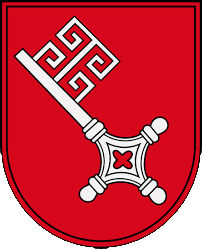Illustrations of the Curtius - Korte - Kur(t)z(e) (and similar sounding surnames) family coats of arms and merchant marks.
Further information (if any) will be found within the password protected members' area of this website.
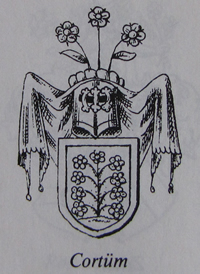 |
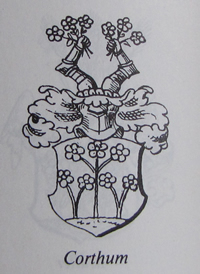 |
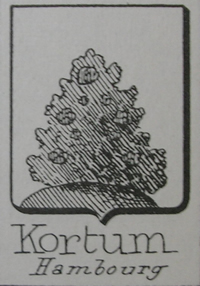 |
| C(K)ortüm of Ostfriesland, Mecklenburg and Westfalen; see Corthum & Kortum. | C(K)orthum of Ostfriesland, Mecklenburg and Westfalen; see Cortüm & Kortum. | Kortum of Hamburg, Deutschland [Germany]; see Corthum & Cortüm. |
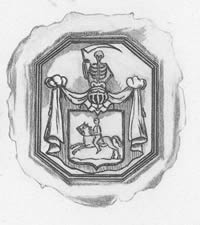 |
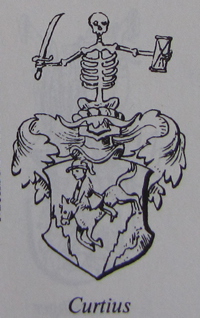 |
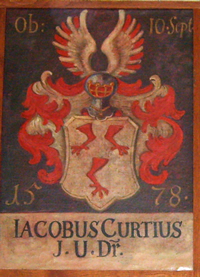 |
| Curtius alias Kurtze alias Korte of Bremen, Lippe & Duisburg, Deutschland [Germany]. | Curtius alias Kurtze alias Korte of Lippe, Deutschland [Germany]. | Curtius of Constanz, Bodensee, Baden-Württemberg, Deutschland [Germany]. See de Corte of Flanders mentioned in the Armorial Général. |
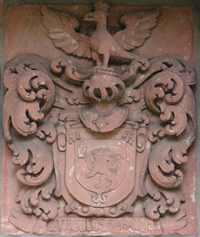 |
 cropped.jpg) |
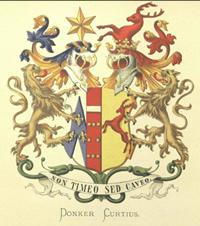 |
| Curtius alias Curti of Groß-Umstadt, Hessen, Deutschland [Germany], England, Italy and Sweden. | Curtius alias De Corte of Liege, België / Belgique / Belgien [Belgium]; see Donker Curtius. | Donker Curtius, of België / Belgique / Belgien [Belgium] and Nederland [Netherlands]; see Curtius alias De Corte. |
 |
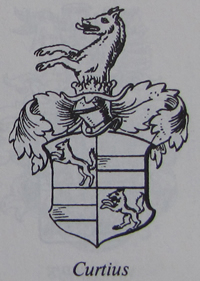 |
|
| Curtius alias Korte of Lübeck, Schleswig-Holstein, Deutschland [Germany] and København [Copenhagen], Danmark [Denmark]. | Curtius of Deutschland [Germany]. | |
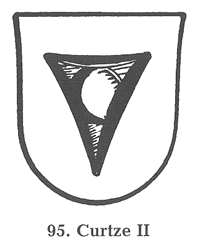 |
 |
|
| Curtze alias Kurtze of Waldeck, Hessen, Deutschland [Germany]. | Khurtz of Ratisbon (Regensburg), Bayern, Deutschland [Germany]. | |
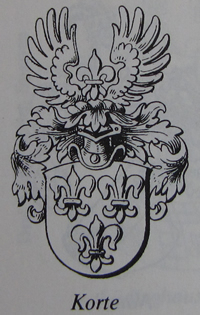 |
 1901 to 1903. Tafel 86 Corte - 200px.jpg) |
 |
| Korte of Deutschland [Germany]. | Korte of Böderich, Werl, Soest, Westfalen, Deutschland [Germany]. | Korte alias Cortse of Amsterdam, Holland [Netherlands]. |
, plate CCCXLII.jpg) |
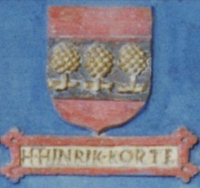 |
|
| De Korte alias De Corte of Brugge, België / Belgique / Belgien [Belgium]. | Korte of Verden (am Aller), Niedersachsen, Deutschland [Germany]. | |
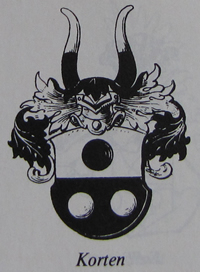 |
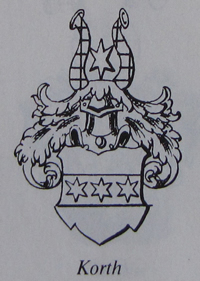 |
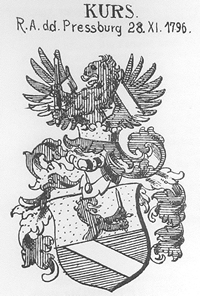 |
| Korten of Deutschland [Germany]; see Kurtz alias Kurz of Schwäbische Hall. | Korth of Deutschland [Germany]. | Kurs of Pressburg (Bratislava) [Bratislava], Slovenská [Slovakia]. |
 |
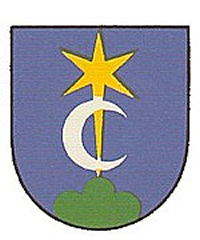 |
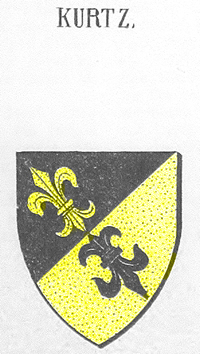 |
| Kurtz of Deutschland [Germany]. | Kurtz of Appenzell, Schweiz [Switzerland]. | Kurtz (Gülten-Bereitung), Oberösterreich, Österreich [Austria]. |
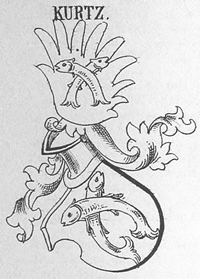 |
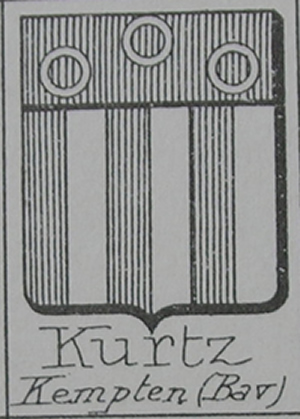 |
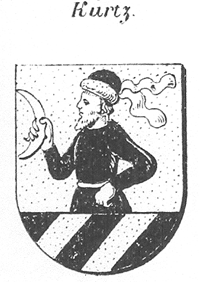 |
| Kurtz of Hohenwaldeck, Bayern, Deutschland [Germany]. | Kurtz of Kempten, Bayern, Deutschland [Germany]. | Kurtz of Nürnberg, Bayern, Deutschland [Germany]. |
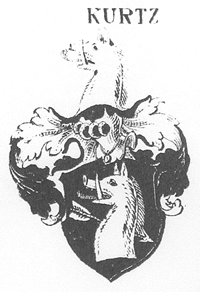 |
 |
|
| Kurtz of Regensburg, Bayern, Deutschland [Germany]; see Kurz of Ulm. | Kurtz of Reutlingen & Stuttgart, Baden-Württemberg, Deutschland [Germany]; see Kurz of Bern and Langnau and Kurz alias Kurtz of Oberdiebach. | Kurtz alias Curtius of Reutlingen, Baden-Württemberg, Deutschland [Germany]. |
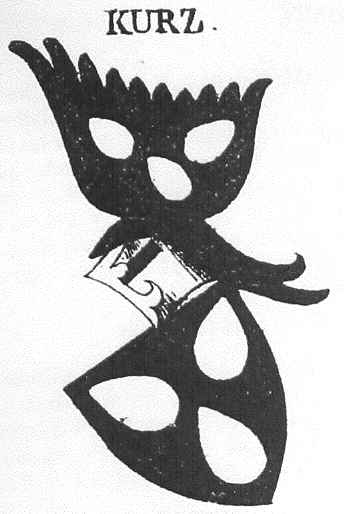 |
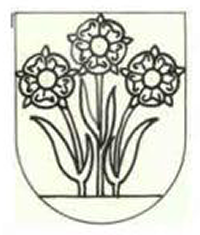 |
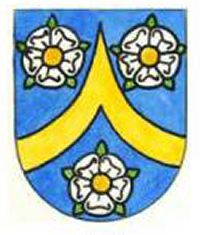 |
| Kurtz alias Kurz of Schwäbische Hall, Baden-Württemberg, Deutschland [Germany]; see Korten. | Kurtz of Thun, Switzerland. | Kurtz of Thun, Switzerland. |
 |
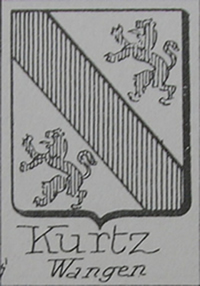 |
|
| Kurtz of Velden, Nürnberg, Bayern, Deutschland [Germany]. | Kurtz of Wangen, Baden-Württemberg, Deutschland [Germany]; see Kurz of Pfaffenweiler. | |
. Appenzellisches Wappen- und Geschlechterbuch, 1926..jpg) |
||
| Kurtzer of Appenzell, Schweiz [Switzerland]. | ||
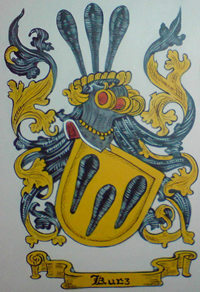 |
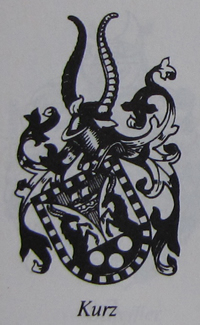 |
|
| Kurz of ? | Kurz. The arms seem to combine those of Kurtz of Senftenau; Kur(t)z of Schwäbische Hall and Kurz of Raudern. | |
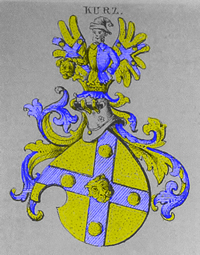 |
|
. Berner Wappenbuch, 1932..jpg) |
| Kurz of Bayern, Deutschland [Germany]. | Kurz of Bern and Langnau, Schweiz [Zwitzerland]; see Kurtz of Reutlingen and Kurz alias Kurtz of Oberdiebach. | Kurz of Bern, Schweiz [Zwitzerland]; see Kurz of Vechigen. |
. Die Burgergeschlechter von Beromunster, 1931.jpg) |
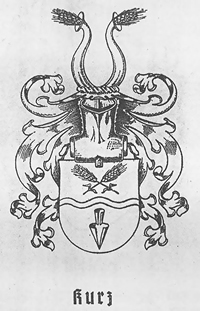 |
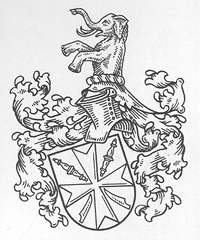 |
| Kurz of Beromünster, Schweiz [Zwitzerland]. | Kurz of Buhlbronn, Baden-Württemberg, Deutschland [Germany]. | Kurz of Deggingen, Baden-Württemberg, Deutschland [Germany]. |
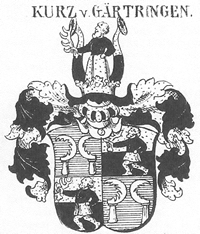 |
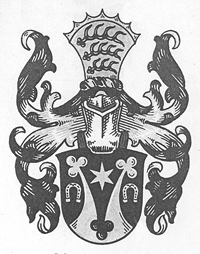 |
|
| Kurz of Gärtringen, Baden-Württemberg, Deutschland [Germany]. | Kurz of Thun, Goldenstein & Salzburg, Österreich [Austria]. | Kurz of Hausen an der Zaber, Baden-Württemberg, Deutschland [Germany]. |
 |
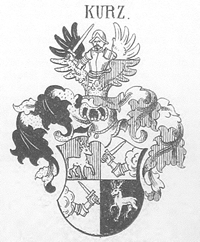 |
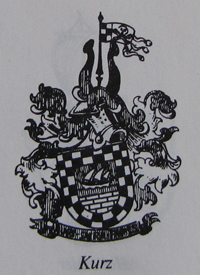 |
| Kurz of Pfaffenweiler, Baden-Württemberg, Deutschland [Germany]; see Kurtz of Wangen. | Kurz of Prag, (Praha) [Prague], Böhmen (Čechy) [Bohemia], Česká Republika [Czech Republic]. | Kurz of Raudern, Nürtingen, Baden-Württemberg, Deutschland [Germany]. |
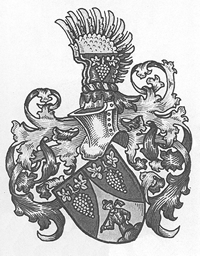 |
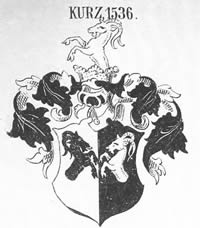 |
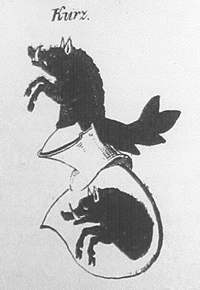 |
| Kurz of Schorndorf, Baden-Württemberg, Deutschland [Germany]. | Kurz of Senftenau, Lindau, Bayern, Deutschland [Germany]. | Kurz of Ulm, Baden-Württemberg, Deutschland [Germany]; see Kurtz of Regensburg. |
 |
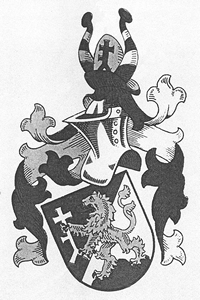 |
|
| Kurz of Vechigen, Bern, Schweiz [Zwitzerland]; see Kurz of Bern. |
|
Kurz alias Kurtz of Oberdiebach, Baden-Württemberg, Deutschland [Germany]; see Kurtz of Reutlingen and Kurz of Bern and Langnau. |
Tinctures provide the limited palette of colours and patterns used in heraldry. Some of the above images when drawn in black and white are 'tricked' in a certain hatching to depict the colour. Wikipedia provides an explanation https://en.wikipedia.org/wiki/Tincture_(heraldry) but I have replicated their legend as follows:
General armorial indexes, listing Curtius surnames and coats of arms:
On the Internet there are a great many references to heraldry, sometimes these sites are sadly transient, closed and then the information is lost. A good website is Heraldica by Francois R. Velde; which in order to preserve his painstaking research I have also copied below the information appertaining to Germanic areas of Europe:
General Books on Heraldry:
Germany
- Gritzner, M. Handbuch der heraldischen Terminologie in zwölf Zungen. Nürnberg: 1890. A dictionary of heraldic terms with definitions in German but translations of the terms in 11 other languages. Cross-indexed with Ordinaries like Renesse and Papworth.
- Hildenbrand, A.M. Wappenfibel. Handbuch der Heraldik. Neustadt an der Aisch: 1970. Very clear, basic textbook on heraldry.
- Oswald, G. Lexicon der Heraldik. Leipzig: 1984. Fairly elementary.
Glossaries
Most heraldic treatises will contain a glossary of some form. To interpret obscure terms, or translate from one language to another, one must resort to specialized glossaries.
- Rietstap, Johannes Baptist: Armorial général. Listed under General Armorials. It contains a short glossary with illustrations; useful to identify some exotic terms. In French.
- J. Siebmacher: Großes Wappenbuch, Band B: Wappenbilderordnung oder Symbolorum Armorialium Ordo. Neustadt an der Aisch: Bauer & Raspe, 1990. This is a re-edition of Maximilian Gritzner's Handbuch der heraldischen Terminologie of 1890, prepared by Jürgen Arndt and Werner Seeger, as part of the new Siebmacher collection. All terms in eleven languages (German, Medieval High German, Danish, English, French, Italian, Latin, Dutch, Portuguese, Swedish, Spanish) are listed alphabetically, with translations and references to the location of the terms in Renesse and Papworth (see Ordinaries). Volume I contains the illustrations, Volume II the lexicon itself.
Armorials or Armories:
General
An armorial or armory goes from name to arms: it lists family names alphabetically and provides the blazon (verbal description) of a coat of arms. An ordinary goes from arms to names: it lists coats of arms analytically and provides the name(s) of families who bore those arms.
Rietstap
The most general armory was compiled by Johannes Baptist Rietstap (1828-91) in the late 1800s, and it covers all of Europe, over 100,000 arms. The Rietstap is far from complete, it is not free of errors (though it is on the whole reliable). The biggest problem is that it gives no references. The information is limited to name, origin (country or province) and arms (often with supporters, crest and motto); occasionally some information on title creation (for titled nobility).
Rietstap's Armory is now online in searchable form.
Victor Rolland (1843-1912) and Henri Rolland (1887-1970) added several volumes of supplement, and also illustrated all the arms in the Rietstap (the illustrated general armorial listed below, which contains only plates of coats of arms).
Rietstap, Johannes Baptist: Armorial général.
- Original Editions:
- First edition: Gouda: G. B. van Goor, 1861.
- New edition: Amsterdam: Theod. Bom, 1875 (1 vol.).
- Second edition, much enlarged: Gouda: G. B. van Goor, 1884-87 (2 vols).
available online at Gallica (note: in image format, not as searchable text! Type Rietstap in the search field to find the images from the book(s))
- Reprints:
- Berlin: Stargardt, 1934.
- Baltimore; Genealogical Publishing Co, 1965.
- London: Heraldry Today, 1965; also 1972.
- Supplement:
- Victor and Henri Rolland: Armorial général de J. B. Rietstap, Supplément. La Haye: M. Nijhoff, 1926-54 (7 volumes).
- Illustrations:
- Rolland, Victor: Armoiries des familles contenues dans l'Armorial général de J. B. Rietstap. Paris: Institut Héraldique Universel, 1903-1926 (6 volumes).
- Reprints:
- General Illustrated Armorial. Lyon, 1953-54: Sauvegarde Historique.
- V. & H. V. Rolland: Illustrations to the Armorial general by J. B. Rietstap. Baltimore: Heraldic Book Co., 1967 (6 volumes in 3).
- Reprinted London: Heraldry Today, 1967, 6 volumes in 3; also 1991.
There are many armories for various countries and for various regions within countries. To find an armory for a specific region, consult a heraldic bibliography. Here are a few general suggestions.
Central Europe
Siebmacher
The main armory for the former lands of the German and Austrian empires is J. Siebmacher's großes Wappenbuch.
Johann Siebmacher (d. 1611) published in 1605 in Nürnberg a New Wapenbüch with 3320 arms fully illustrated (reprinted in Dortmund: Harenberg, 1988). This armory was continually enlarged and reprinted over the years by Paul Fürst (who added a 2nd part in 1612, then a 3d and 4th part in 1655) and then by his heirs (with varying titles such as Das neue teutsche Wappenbuch, Das erneuerte teutsche Wappenbuch Das erneuerte und vermehrte teutsche Wappenbuch, Erneuert und vermehrtes Wappen-Buch , etc). The 1701-05 edition, with all additions up to 1772, was reprinted in facsimile in a single volume (Munchen: Battenberg, 1975). In 1734, a new edition was done by the the publisher Raspe in Nürnberg (restoring Siebmacher's name to the title page) with 12 supplemental volumes issued from 1753 to 1806 (reprinted in facsimile: München: Battenberg, 1979), at which point the collection contained 19,000 fully illustrated arms (it is known as the "old" Siebmacher).
In 1854, the same publisher (now Bauer u. Raspe) began a new edition, called Siebmacher's großes und allgemeines Wappenbuch, which continued until 1961, totalling 101 volumes (known as the "new" Siebmacher). The publisher Degener, Bauer and Raspe in Neustadt-an-der-Aisch has reprinted the original volumes in facsimile, but condensed into 35 volumes, from 1970 to 1985. A microfilm edition exists in 178 reels (Wooster, OH: Micro Photo Division, Bell & Howell, 1971).
Both the old and the new Siebmacher have been published as a set of 441 microfiches:
- Die Siebmacherschen Wappenbücher der "alte" Siebmacher (XVIII Teile) und der "neue" Siebmacher (101 Bände), neu zusammengeführt und alphabetisch geordnet. Erlangen: 1998, Fischer (ISBN 3891312938).
How does one find a name in this mass of books? An index of the 130,000 names in all editions of Siebmacher from 1605 to 1961 has been published:
- Jäger-Sünstenau, H. General-Index zu den Sibmacher'schen Wappenbücher (1605-1967). Graz: 1964 (General-Index), 1969 (Nachtrag). Second edition (enlarged) 1984.
The Siebmacher collection begins with the arms and flags of the states of the world (vol. 1), arms of the German rulers (vol. 2), of the German high nobility or mediatized houses (vol. 3-4), of European princes (vol. 5), cities (vol. 6), guilds and universities (vol. 7), sees and abbeys (vol. 8), and burgher arms (vol. 9-13), that is, arms of non-noble citizens of cities. The rest of the collection (vols. 14-35) covers the provincial nobilities, by area (Germany first, then the Autro-Hungarian empire in volumes 26-35).
The currently reprinted volumes are as follows (with corresponding volume and part numbers of the original edition):
- 1. Die Wappen und Flaggen der Herrscher und Staaten der Welt, 1978
1.Bd., 1.Abt. (1856), 1.Bd., 2.Abt. (1870), 1.Bd., 6.Abt. (1878), 7.Bd., 1.Abt. (1859). - 2. Die Wappen der deutschen Landesfürsten, 1981
Band, 1. Abteilung, 2.-5. Teil (1909-29) - 3-4. Die Wappen des hohen deutschen Adels, 1972-74.
1. Bd., 1.-3. Reihe mit Anh., (1878-1888) - 5. Die Wappen der europäischen Fürsten, 1975
I. Bd., 3. Abt., III. Reihe, C, (1894) - 6. Wappen der Städte und Märkte in Deutschland und den angrenzenden Ländern, 1974
Bd., 1 Abt. 4 (1885) - 7. Berufswappen; Die Siegel der deutschen Universitäten, 1976
Bd. 1, Abt. 7 (1898); Abt. 8 (1906) - 8. Die Wappen der Bistümer und Klöster, 1976
1. Bd., 5. Abt., 1. Reihe mit Anh. u. 2. Reihe (Nurnberg 1881/82) - 9-13. Die Wappen bürgerlicher Geschlechter Deutschlands und der Schweiz (5 vol.), 1971-75
5. Bd., 1.-12. Abt. ; 5. Bd., n. F., 1.-3. Abt., Nurnberg 1857-1961. - 14-16. Die Wappen des preussischen Adels, 1973-
- 17. Die Wappen des schlesischen Adels, 1977
Bd. 4, Abt. 11 (1885) u. Bd. 6, Abt. 8, Teil 1-3 (1887-1894) - 18. Die Wappen des Adels in Pommern und Mecklenburg, 1978
VI. Bd., 9. Abt. (1894); VII, Bd., 3. Abt., c (1900); III. Bd., 6. Abt. (1858); VI. Bd., 10. Abt. (1902); VII. Bd., 1 Abt. (1859) - 19. Die Wappen des niederdeutschen Adels : (Schleswig-Holstein-Lauenburg, Hamburg, Bremen, Lubeck, Oldenburg, Lippe, Schaumburg, Hannover, Braunschweig, Anhalt), 1977
Bd. 2, Abt. 2 (1869), Bd. 2, Abt. 9 (1870), Bd. 3, Abt. 3 (1871), Bd. 3, Abt. 5 (1872), Bd. 3, Abt. 7 (1869), Bd. 3, Abt. 8 (1877), Bd. 3, Abt. 10 (1872) and Bd. 6, Abt. 11 (1905) - 20. Die Wappen des hessischen und thüringischen Adels, 1977
Bd. II, III, VI, and VII (1856-1908) - 21. Die Wappen des sächsischen Adels, 1972
- 22. Die Wappen des bayerischen Adels, 1971
2. Bd., 1 Abt. (1856); 6. Bd., 1. Abt., 1-3. T. (1884, 1906 u. 1911); 7. Bd., 1. Abt. (1859) - 23. Die Wappen des Adels in Württemberg, 1982
Bd. 2, Abt. 5 (1856), Bd. 6, Abt. 2 (1911) and Bd. 7, Abt. 1 (1858) - 24. Die Wappen des Adels in Baden, Elsass-Lothringen und Luxemburg, 1974
2. Bd., 6 Abt. (1878), 10. Abt. (1871), 11. Abt. (1873), 3. Bd., 9. Abt. (1871) - 25. Der Adel der russischen Ostseeprovinzen (Estland, Kurland, Livland, Oesel), 1980
Bd. 3, Abt. 11 (1898) - 26. Die Wappen des Adels in Niederösterreich, 1983
4. Bd, 4. Abteilung (1909-18) - 27. Die Wappen des Adels in Oberösterreich, 1984
4. Bd., 5. Abt (1904) - 28. Die Wappen des Adels in Salzburg, Steiermark und Tirol, 1979
Bd. VI, 1. Abt. (1857), 6. Abt. (1883), 7. Abt. (1919-1921); Bd. VI, 3. Abt. (1858); Bd. VII., 1. Abt. (1859) - 29. Der Adel in Kärnten, Krain und Dalmatien, 1980
Bd. 4, Abt. 2 (1859), Abt. 3 (1873), and Abt. 8 (1879) - 30. Die Wappen des böhmischen Adels, 1979
4. Bd., 9. Abt. (1886) - 31. Die Wappen des mährischen Adels, 1979
4. Bd., 10. Abt. (1899) - 32. Der Adel von Galizien, Lodomerien und der Bukowina, 1985
IV. Bd, 14. Abt. (1905) - 33. Die Wappen des Adels in Ungarn, 1982
IV. Band, 15. Abteilung (1885-1894) - 34. Der Adel von Siebenburgen, 1984
4. Bd., 12. Abt. (1898) - 35. Der Adel von Kroatien und Slavonien, 1985
4. Bd., 13 Abt (1899)
The new Siebmacher collection also contains volumes on heraldry:
- Seyler, Gustav Adelbert: Geschichte der Heraldik (Wappenwesen, Wappenkunst, Wappenwissenschaft). Neustadt an der Aisch, Bauer & Raspe, 1970.
- Arndt, Jurge and Werner Seeger: Wappenbilderordnung, herausgegeben vom Herold, Verein für Heraldik, Genealogie und Verwandte Wissenschaften zu Berlin. Neustadt an der Aisch : Bauer & Raspe, 1986-1990.
- Hefner, Otto Titan von: Grundsätze der Wappenkunst : für den Leser des Siebmacherschen Wappenwerkes besonders geschrieben. (Nürnberg 1855.) Neustadt an der Aisch : Bauer und Raspe, 1976.
- Berchem, Egon, Freiherr von, Donald L. Galbreath, Otto Hupp: Beiträge zur Geschichte der Heraldik. (Berlin 1939.) Neustadt (an der Aisch) : Bauer und Raspe, 1972.
- Alberti, Otto von: Württembergisches Adels- und Wappenbuch. (Stuttgart, 1889-1916). Neustadt an der Aisch : Bauer und Raspe, 1975.
- Scholer, Eugen: Historische Familienwappen in Franken : 1860 Wappenschilde und familiengeschichtliche Notizen von Geschlechtern des Adels und der Reichsstädte in Franken. Neustadt an der Aisch : Bauer und Raspe, 1975.
- Meyer, Eduard Lorenz: Hamburgische Wappenrolle : nach hamburgischen Wappenbuchern. Neustadt an der Aisch : Bauer & Raspe, 1976.
For the nobility, the following is very useful, as it contains all patents of nobility for the Holy Roman Empire and the Austrian hereditary lands up to 1806:
- Frank, Karl Friedrich von: Standeserhebungen und Gnadenakte für das Deutsche Reich [i.e. für das Heilige Römische Reich] und die Österreichischen Erblande bis 1806, sowie kaiserlich österreichische bis 1823, mit einigen Nachträgen zum "Alt-Österreichischen Adels-Lexikon" 1823-1918. [s. l.] Selbstverlag, Schloss Senftenegg, Niederosterreich, 1967-74. (5 vol.).
Belgium
- Koller, Fortuné and S. Melia: Armorial général de Belgique. Bruxelles, 1958.
- Janssens, Paul and Luc Duerloo: Armorial de la noblesse belge du XVe au XXe siècle. Bruxelles : Crédit communal, 1992.
- Raadt, Jean-Théodore de. Sceaux armoriés des Pays-Bas et des pays avoisinants. Brussels, 1893-1907, printed in 4 volumes.
Armory of families of the Low Countries based on seals. With interesting general remarks on heraldic practice as manifested in these seals. Available online at the Gallica website.
Luxembourg
- Loutsch, Jean-Claude: Armorial du pays de Luxembourg : contenant la description des armes des princes de la maison de Luxembourg, de tous les souverains d'autres maisons ayant régné sur ce pays, des gouverneurs ayant exercé le pouvoir en leur nom, ainsi que celles des familles nobles, bourgeoises ou paysannes, pour autant qu'elles ont pu être retrouvées. Luxembourg : Ministère des arts et des sciences, 1974. (869 p., [4] leaves of plates : illus. ; 29 cm.).
- Siebmacher: Die Wappen des Adels in Baden, Elsass-Lothringen und Luxemburg. Neustadt (an der Aisch) : Bauer und Raspe, 1974. Reprint of Siebmacher's Wappenbuch, 2. Bd., 6. Abt. (Nurnberg 1878), 10. Abt. (Nurnberg 1871), 11. Abt. (Nurnberg 1873), 3. Bd., 9. Abt. (Nurnberg 1871).
Switzerland
- Baud, John: Armorial du Chablais. Genève : Slatkine Reprints ; Thonon-les-Bains : Archives de l'Académie chablaisienne, 1993.
- Dumont,:Eugène-Louis. Armorial genevois. Genève : Editions Slatkine, 1977.
- Galbreath, Donald Lindsay: Armorial vaudois. Genève : Slatkine, 1977.
- Rappard, François J.: Heraldica helvetica. Genève : MRO Heraldica, c1993.
A large illustrated armorial of Swiss families.
Ordinaries:
Just as there is no complete armory, there is no complete ordinary. But ordinaries have been published for specific armories:
- For Europe, there is an ordinary which corresponds to Rietstap's armory:
- comte Théodore de Renesse: Dictionnaire des figures héraldiques. Bruxelles: O. Schepens, 1894-1903. (7 volumes).
- reprint in one volume (Leuven: 1992, Jan van Helmont).
- For Germany, Neubecker has produced an ordinary of the non-noble arms in Siebmacher (vols. 9-13). It contains pictures of the arms only, arranged by principal charge, and contains 21,000 arms with a nominal index:
- Neubecker, Ottfried: Großes Wappen-Bilder-Lexikon der bürgerlichen Geschlechter Deutschlands, Oesterreichs und der Schweiz. Battenberg, München, 1985. (1147 p.)
You need to have the Rietstap (2nd edition) in hand as well, because Renesse will not give the full blazon for each name.
- Rentzmann, Wilhelm: Numismatisches Wappen-Lexicon des Mittelalters und der Neuzeit. 1876. Facsimile reprint: Osnabrück: Otto Zeller, 1967.
- Neubecker, Otffried and Wilhelm Rentzmann: Wappen-Bilder-Lexikon. München: Battenberg, 1974. 418 p.
- Neubecker, Otffried and Wilhelm Rentzmann: 10,000 Wappen und Embleme von Staaten und Stadten nach Bildmotiven angeordnet. München: Battenberg, 1989.
In addition, many of the publications of medieval rolls of arms or regional armorials will include an ordinary at the end, but these will be difficult to use, since they are dispersed in many publications.
Genealogies:
Genealogies, pedigrees or family trees record family lineages and are usually shown as written text or otherwise as a graphical illustration. Different countries have their own definitive sources that are often referred to as the authentic source of information. In England it would be the College of Arms, which grants coats of arms and also records family trees; or one of several other reputable institutions. Also, well regarded publications such as Burkes Peerage, Baronetage and Knightage published from 1826 with many following editions; likewise Debrett's Peerage and Baronetage. Similar to these British publications for Germany is the Almanach de Gotha which was first published in 1763 and also included many non-German genealogies. Although there are many editions of these published books, it is a tragedy that the Russian army deliberately destroyed the Almanach de Gotha's archives in 1945. This publication was revived after 1951 by the publisher C.A. Starke and called Genealogisches Handbuch des Adels. These aforementioned publications deal with Royalty the nobility, but there are of course similar publications for the 'commoners' (albeit wealthy and influential upper class 'commoners').
For the upper class but non-noble families the best source in the United Kingdom is Burke's Landed Gentry (originally titled Burke's Commoners) which was published from 1833 onwards; in the Netherlands it is the Nederland's Patriciaat; and in Germany it is the Genealogisches Handbuch bürgerlicher Familien, then renamed after 1943 as the Deutsches Geschlechterbuch; of which I have volume 11, published in 1904 and containing the genealogy of Kurtz, Kurz, von Kurtz family of Kirchentellinsfurt and Reutlingen in Württemberg from page 205 to 280.
For genealogical tables of the high nobility shown in traditionally drawn family trees then you can do no better than the series of books called the Europäische Stammtafeln, which currently consists of 29 volumes and are the standard reference books for those researching medieval, imperial, royal and noble families of Europe; published by Vittorio Klostermann. I am fortunate to possess 24 volumes of this excellent work; for advice on this publication click on the following link provided by John P. DuLong.
For the real 'common folk' there are countless family history societies in existence, usually based on a particular region, family societies, and one-name study groups; all with scholarly publications.
Click on the "Key Shield" hyperlink below to access my password protected research on the genealogies of various Kurtze families and family coats of arms. Currently the Korte / Curtius / Kurtze of Bremen, Lippe, Kassel etc. database contains 846 people; the Kurtz family of Reutlingen contains 1246 people; Kurtze alias Curtze family of Waldeck contains 670 people; Korte alias Curtius of Lübeck contains 48 people and the other families are represented by smaller numbers in the database. My own Van Zomeren Warringa family from the provinces of Groningen and Drenthe in the Northeastern Netherlands contains references to nearly 16,000 people. The genealogies are fully interactive with hyperlinks, images, sources, maps, etc.
Some of the family genealogical information provided in my research is extensive, whilst in some others it is negligible. If you have anything to contribute to this website it will be gratefully received. See where and if you fit in?
Click on Arms of the City of Bremen above to unlock the access into my password protected members' area and discover the Curtius - Korte - Kur(t)z(e) and Van S/Zomeren research


. Berner Wappenbuch, 1932.jpg)
